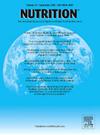Calf circumference-albumin index significantly predicts the prognosis of older patients with cancer cachexia: A multicenter cohort study
IF 3.2
3区 医学
Q2 NUTRITION & DIETETICS
引用次数: 0
Abstract
Objectives
The aim of this study was to evaluate the combined prognostic value of calf circumference (CC) and serum albumin on mortality in patients with cancer cachexia aged ≥65 years.
Methods
This multicenter cohort study involved 5322 older patients in hospital with cancer cachexia. The combined indicator of CC and albumin was defined as the calf circumference-albumin (CCA) index. Harrell's C index, a time-dependent receiver operating characteristic curve analysis, was used to assess the prognostic performance of the CCA index and other indices. The optimal thresholds method was used to determine the cutoff values of CC and albumin, and the association between the CCA index and all-cause mortality was assessed using Kaplan-Meier analysis and Cox proportional hazard regression models.
Results
A total of 3875 men and 1447 women with a mean age of 72.0 years (range: 68.0–78.0 years) and a mean follow-up time of 55.0 months (range: 25.0–85.0 months) were included in the study. A total of 1269 patients were classified into the low CCA index group (0 score) by the optimal thresholds method. In the overall population, the CCA index showed better differentiating power at predicting mortality in older patients with cancer cachexia compared with CC or albumin alone (C index = 0.639; 95% CI: 0.612–0.666; P < 0.05). The time-dependent receiver operating characteristic curve showed that the CCA index had the highest prognostic value of all the measures studied (P < 0.05). In the overall population, male and female patients with a high CCA index (2 score) showed better performance than those with a low CCA index (0 or 1 score).
Conclusions
The CCA index could significantly predict the mortality of older patients with cancer cachexia, which might provide renewed assistance for future clinical management.
小腿围-白蛋白指数可显著预测老年癌症恶病质患者的预后:一项多中心队列研究
研究目的本研究旨在评估小腿围(CC)和血清白蛋白对年龄≥65 岁癌症恶病质患者死亡率的综合预后价值:这项多中心队列研究涉及 5322 名住院的癌症恶病质老年患者。CC和白蛋白的综合指标被定义为小腿围度-白蛋白(CCA)指数。哈雷尔 C 指数是一种时间依赖性接收器操作特征曲线分析法,用于评估 CCA 指数和其他指数的预后效果。采用最佳阈值法确定CC和白蛋白的临界值,并使用卡普兰-梅耶分析和考克斯比例危险回归模型评估CCA指数与全因死亡率之间的关系:研究共纳入 3875 名男性和 1447 名女性,平均年龄为 72.0 岁(范围:68.0-78.0 岁),平均随访时间为 55.0 个月(范围:25.0-85.0 个月)。按照最佳阈值法,共有 1269 名患者被归入低 CCA 指数组(0 分)。在总体人群中,CCA 指数与单独的 CC 或白蛋白相比,在预测老年癌症恶病质患者死亡率方面显示出更好的区分能力(C 指数 = 0.639;95% CI:0.612-0.666;P <0.05)。与时间相关的接收器操作特征曲线显示,在所有研究指标中,CCA 指数的预后价值最高(P < 0.05)。在总体人群中,CCA指数高(2分)的男性和女性患者比CCA指数低(0分或1分)的患者表现更好:结论:CCA指数能明显预测老年癌症恶病质患者的死亡率,这可能为今后的临床管理提供新的帮助。
本文章由计算机程序翻译,如有差异,请以英文原文为准。
求助全文
约1分钟内获得全文
求助全文
来源期刊

Nutrition
医学-营养学
CiteScore
7.80
自引率
2.30%
发文量
300
审稿时长
60 days
期刊介绍:
Nutrition has an open access mirror journal Nutrition: X, sharing the same aims and scope, editorial team, submission system and rigorous peer review.
Founded by Michael M. Meguid in the early 1980''s, Nutrition presents advances in nutrition research and science, informs its readers on new and advancing technologies and data in clinical nutrition practice, encourages the application of outcomes research and meta-analyses to problems in patient-related nutrition; and seeks to help clarify and set the research, policy and practice agenda for nutrition science to enhance human well-being in the years ahead.
 求助内容:
求助内容: 应助结果提醒方式:
应助结果提醒方式:


